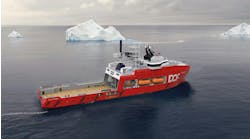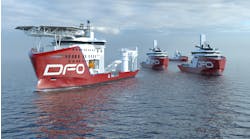Weather shutdown triggers industry
Ken Serigne
Elevating Boats Inc.
Not long after establishing Universal Repair Service in 1949, a business that claimed to be able to "fix anything except a broken heart and the break of day," Lynn Dean and his twin brother, Orin, were called upon to solve a common problem in the developing offshore oil business. Unbeknownst to them, their experience would lead to the creation of a new marine industry.
- Self-elevating service vessels have been a part of the offshore scene since 1955. Shown is the Sal Duhe (Photo courtesy of Elevating Boats, Inc.).
- The Jehu, one of Elevating Boat's earliest vessels, was constructed for $22,000. The vessel was designed to move seismographic operations out of the wave zone.
- The Gulf Driller elevating boat was purpose built for seismographic operations, as were most such vessels at the time. Only later were they used to support platform and drilling operations.
While offshore on a welding assignment for a seismographic crew near Delacroix Island in Southeast Louisiana, Lynn Dean was forced to wait for several hours before he could perform his job. About 75 workers were idle on a quarterboat, waiting for seas to calm so they could perform their duties.
Upon seeing this tremendous waste of labor, Lynn inquired as to what the problem was. He was informed that the wave action moved the seismographic vessels around so badly that they would bend the spuds that held them in place. The situation was too dangerous, and the spud repairs too costly. Therefore, the job was shut down.
The party chief on the job explained the situation to Lynn: "If you could build a boat that could work in waves like that, you could make a fortune." Hearing that statement and having many hours offshore to ponder this new concept led to the creation of the "elevating boat," as Lynn Dean called it. This new boat would revolutionize the way oilfield service activities were performed and would pave the way for a new marine industry - the liftboat industry.
By the time Lynn Dean graduated from high school in New Orleans (1940), he had already begun working as a marine engineer on river towboats. He was formally trained and received a diesel/steam marine engineer's license in 1947. He was one of the youngest men to serve as chief engineer on vessels at that time. He had developed a passion for marine engineering and had a keen mathematical mind combined with a mechanical aptitude.
He and his brother's first business, Universal Repair Service, was an automotive repair, welding, and machine shop that truly repaired just about anything that needed fixing. This successful business gave life to Elevating Boats Inc. (EBI). EBI has built over 140 liftboats since the creation of the Jehu Elevator in 1955 and at one time operated a fleet of 65 vessels.
Cable lift legs
The first liftboat was simple in design, but carefully thought out. The vessel had four legs with two mud mats that retracted into the hull for smooth water flow. The Dean brothers had laid a 1/8-in. thick steel plate on sand and beat it into shape with sledge hammers, creating very smooth compound curves. Using this technique, they created an efficient tunnel section, allowing them to recess the propeller into the bottom of the hull. This enabled the vessel to operate in shallow water with very little flow resistance. The boat was made primarily out of 12 gauge and 16 gauge material and was very light in weight.After completing a total overhaul of a secondhand GM 6-71 diesel engine and Twin Disc marine gear, the vessel was outfitted with its single propeller and achieved speeds of 12 mph with its engine turning at 1700 rpm. The boat was hoisted up the legs by cables on pulleys that were pulled by a second hand truck rear end. Dean had assembled this differential with a clutch on the engine, separate brakes on each of the wheels, and a chain drive mechanism that provided independent movement of the four legs. All said and done, he had created the first liftboat for the oil industry for a cost of roughly $22,000.
The boat was named the Jehu and it got its first job with Shell Oil Company. It performed remarkably well doing the seismographic work that had inspired its creation. After the Dean brothers had completed their third vessel, there was a slowdown in the oil industry. Seismographic activity slowed to a crawl and the first two boats were laid off. This provided an opportunity for Orin Dean to try this odd new vessel out for some recreational fishing. Well, as luck would have it, some knowledgeable people who witnessed the fishing excursion commented to Orin that this vessel would be perfect for something called "wireline work." This opened another door for the liftboat and the Dean brothers were hard at work again adding to their fleet.
Upon completion of the Jehu, Gulf Driller, and the Paraffm Cutter, EBI built the Big Elevator, a 42 ft wide by 65 ft long vessel with eight legs, all cable elevated. These early vessels had proven their usefulness in the oilfield, and other South Louisiana builders were now ready to join EBI in creating their own liftboat fleets.
Otis Engineering was an early pioneer with a four legged cable liftboat of its own. Cheramie, Bollinger, Sun Contractors, Halter Marine, Blue Streak, Dynamic Marine, Crown Point, and others all became an early part of this exploding new liftboat industry with vessel designs of their own The limits of the liftboat's usefulness were expanded with the added creativity and innovations of many different designers and builders. It wasn't long before many oil service companies recognized the need for liftboats in their operations. Some of the liftboat operators of the 1960s and 1970s, in addition to EBI, were Floatation Services, Klein Deco, Allied wireline, Cardinal Wireline, and Macco/Schlumberger.
Having proven the obvious need for these vessels in the oilfield, the challenge now was to build a more reliable and maintenance free vessel. The truck rear end gave way to hydraulic power.
Hydraulics, racking
The addition of hydraulics on the offset elevator was the first significant advance in the design of the liftboat. Hydraulics proved to be a very dependable, and most importantly, durable means for jacking systems in the severe salt sea environment. The next significant advance was the use of a gear rack and pinion system for jacking, as was used on the gear elevator.Cables were fine for elevating vessels, and withstood the tremendous vibration of seismographic explosions particularly well. Their ability to stretch and give softened the blow felt onboard the vessel. However, cables proved to be a heavy maintenance item in a salt sea environment. The flame cut gear rack welded to a pipe leg, driven by a pinion gear powered by a hydraulic system was a tremendous upgrade to the performance and durability of the liftboat.
Another advance in the elevated stability of the liftboat was the use of three legs rather than four. The use of four legs provided the ability to pin two legs together with one mat or pad at the bottom. This provided for greater bearing area on the seafloor, but it had the potential for loading the two diagonally opposed legs greater than the other two legs on an uneven sea bottom. By using only three legs, first attempted on the tripod elevator, the legs could be loaded more evenly.
Load sensing
As technology has advanced, some of the early disadvantages of one design or another have been overcome; designers are very innovative in their thinking. Four legs can be loaded evenly by compensating for leg penetration using load sensing techniques. Electric power for jacking, as used by Dynamic Marine or the newest Danos & Curole designs, has been made more reliable and tolerant of the salt sea environment by utilizing better techniques to seal and isolate electrical components.The use of cranes on liftboats has become vital to the vessel's activities. The first boats had rather small cranes in support of seismographic or wireline activity. Some boats of today have cranes onboard that lift in excess of 200 tons, thus opening entire new opportunities for use in plugging and abandonment, salvage, or new construction activities.
Vessels such as the Irish Sea Pioneer of Halliburton or the Trident Crusader of Searex have utilized the advantages of lattice legs to reduce weight and drag force on legs. The design of heavy lift cranes mounted around the legs of a vessel, such as Power Offshore's Power 250, allowing for increased deck space, is another example of innovative liftboat design.
Many of the modern liftboats provide quite spacious and comfortable living accommodations, enabling them to serve in the capacity of a quarter boat as well as perform their main job activities. U S Coast Guard rules allow for the carrying of as many as 36 offshore workers onboard a liftboat.
The ingenious and creative ability of a self-taught and very independent thinking man who developed the first liftboats has been succeeded by a diverse mixture of talented design engineers who utilize the latest in technology for their liftboat designs. Designers perform detailed computer analyses of liftboats, in both the floating and elevated modes, in order to create the most lightweight yet safest vessels possible.
Liftboats are studied and modeled under various environmental conditions and thoroughly checked for meeting strict US Coast Guard stability requirements. They are now inspected and certified as an offshore supply vessel meeting many regulatory requirements. The odd little boats with legs of the 1950s and 1960s have grown into a major sector within the oil industry of the Gulf of Mexico and are poised to make their presence felt on an international scale.
Author
Ken Serigne is Chief Engineer for Elevating Boats, Inc. He holds a BS in mechanical engineering from the University of Southwestern Louisiana and has been involved in the design and manufacture of liftboats, hydraulic cranes, and related components since 1985.
Copyright 1999 Oil & Gas Journal. All Rights Reserved.


